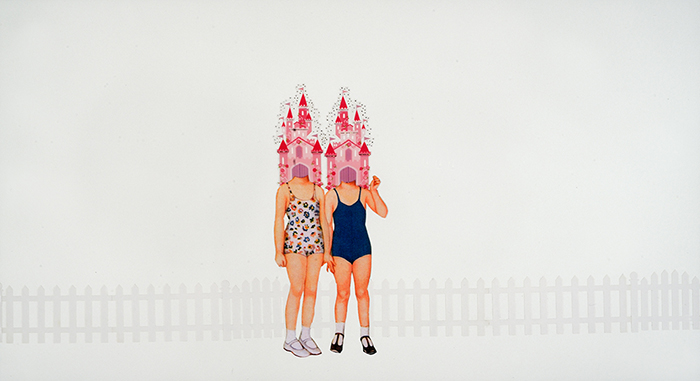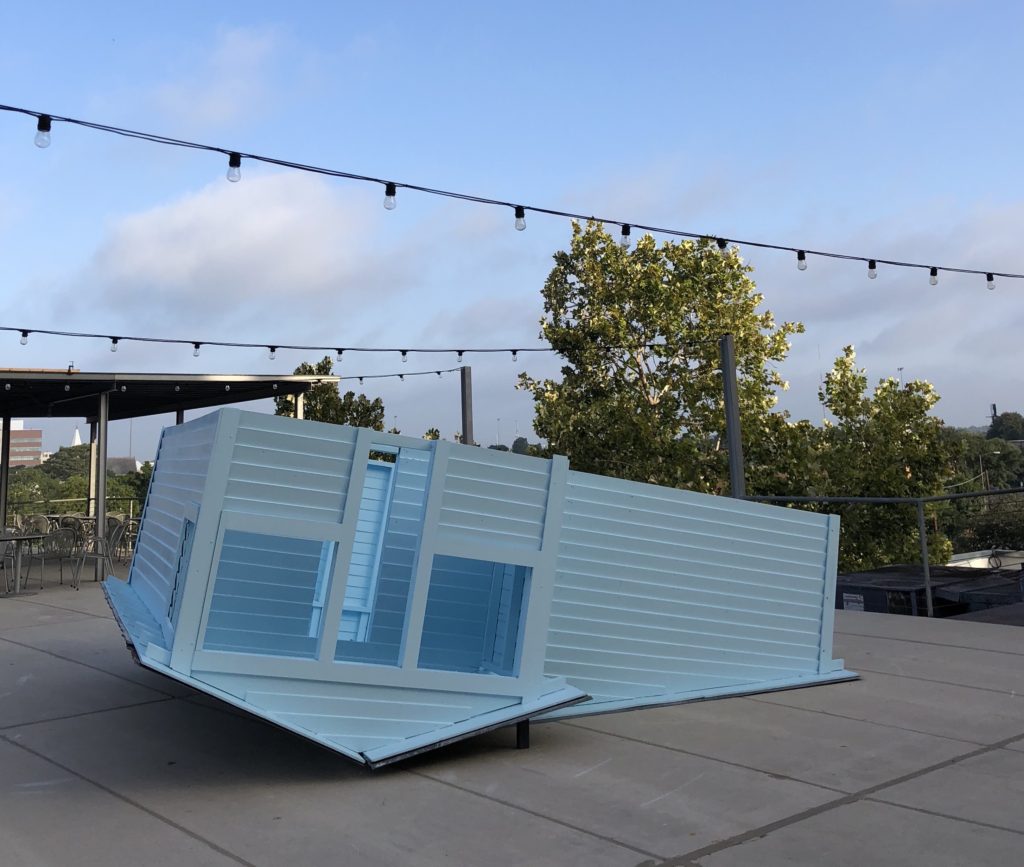Zoë Charlton

Zoë Charlton, Les Demoiselles (The Great Outdoors), 2017. Graphite, gouache, acrylic paint, and collage on paper; 94 x 102 inches.
The artist Zoë Charlton enjoys roaming the aisles of craft stores, filling her basket with an assortment of materials, especially decorative stickers of trees, leaves, clouds, and various birds, such as geese, ducks, owls, and hawks. She appreciates the domestic and democratic approach to creativity that craft stores represent. From scrapbooks to glass beads, from knitting to mosaics, crafting offers an open invitation, it makes no judgement about who can be an artist. Back in her studio, Charlton will scan the stickers, enlarge and print them in quantity, in order to freely use in the construction of collages. Sometimes her collages are relatively simple, combining two or three elements in precise configurations. At other times the collages attain epic proportion, covering walls with visceral narratives. Charlton’s work is physically direct and bracingly contemporary but it is rooted in inextricable histories of nation, family, and identity.
For much of the 20th century, the process of taking or tearing images and objects from their original or ‘natural’ contexts to reassemble into new configurations has been a pervasive artistic practice. Collage was often used as a weapon, a strategy fueled by aggressive social criticism. The great Dada collage artist Hannah Hoch, for example, titled one of her earliest works “Cut with a Kitchen Knife,” subversively connecting violence and domesticity. For the lineage of collage artists, whether that be Hoch and John Heartfield’s anti-fascist photomontages during the Weimar Republic, Romare Bearden’s energized improvisations in Harlem, the ragged high-contrast posters of punk rock, or Barbara Kruger’s feminist interrogation of culture, collage is implicitly rhetorical, taking disparate elements from their original context and colliding them in the hope of shaking things up. Though collage may have lost some of its urgency over the last 100 years, in the hands of an artist of incisive wit and intelligence, such as Charlton, it can still deliver shocks.
Charlton is an Associate Professor at American University and has lived in Baltimore for fourteen years. Surprisingly, her first solo exhibition in her adopted home town wasn’t until this year at School 33. This is not to say that her work has been under the radar, she has been featured in numerous group shows and, perhaps most significantly, was a Sondheim finalist in 2015, presenting an impressive installation of her large-scale drawings and collages at the Baltimore Museum of Art, filling an entire wall with her signature combination of finely-drawn bodies appended with layers of illustrations. Companion, Constant consisted of two naked, dark-skinned male figures, whose backpacks are exploding with bucolic visual references to travel and discovery—sails billowing in the wind, pine and palm trees, puffy cumulus clouds, jumping fish and fowl taking wing, fill the space above and between the men. Like a dark secret, an unacknowledged truth threatening to despoil the idyllic view, African masks, witnesses to history, peek from behind the trees.
If Charlton’s Sondheim works at the BMA guided our thoughts toward colonialism, tourism, and the slave trade, in her School 33 exhibition, The Domestic, Charlton shifts our perspective to examine ideas around the private spaces of domesticity as it relates to the history of race, power, and gender in the United States, and more specifically, her own family history. The show included two series of small collages, Homebodies, and Reared, and two large-scale collage/drawings. Although relatively small, both Homebodies and Reared, practically vibrate with intelligence, wit, and, social observation. Homebodies sutures illustrations of model suburban houses wrapping around 1950s-era idealized images of little (white) girls, fusing these two seemingly-benign symbols into a single hybrid. The image of the home and the little girl are generic symbols, ubiquitous in children’s literature and advertising to represent wholesomeness, innocence, ‘American-ness.’ By emphasizing the constructed quality of seemingly-benign symbols, Charlton’s collages expose the intended purpose of these illustrations to equate whiteness, suburbia and normalcy.
The series Reared is thornier, more pointed in its anger and irony. This time Charlton combines three elements, African masks, unclothed black female torsos, and again, 1950s-era illustrations of little girls. With echoes of the Hottentot Venus, and the ‘mammy,’ large-breasted torsos float behind the girl figures, and seem to drape over, absorb, or maybe even give birth to the girls. There is a lot of heat in this clash of symbols—the black bodies are photographic, specific, almost pornographic, while the girls are illustrations, generic representations of innocence. Charlton told me how she often thinks about the plight of domestic workers who ‘rear’ the children of privilege. She often sees them getting off buses in fancy neighborhoods. What happens to these domestic workers once they enter those private homes with manicured lawns or uniformed doormen? Within these intimate enclosures, these private arrangements, however pleasant, echoes of servitude and American history are played out.

Zoë Charlton, The Country is a Wildness Unsubdued, graphite, acrylic paint, and collage on paper, 2018.
At School 33, Charlton also presented two wall-filling drawing / collages that riffed on the domestic from different angles. The Country is a Wildness Unsubdued is anchored visually and symbolically by a women’s sturdy legs. Reminiscent of Courbet’s painting Origin of the World, we only see her from abdomen to mid-thigh, yet all of life seems to spring forth from her body. In Charlton’s depiction fertility is not pretty, it is exuberant to the point of madness. The woman’s body is covered in a thick tapestry of trees and vines, from which emanate flocks of ducks, geese, owls, pheasants, and other fowl. As with many of Charlton’s works, this piece has both personal and political relevance. At a time when few women, especially women of color, possessed land, Charlton’s grandmother, Evelina, owned several acres in rural Florida, and Charlton spent much of her youth there.
Her grandmother’s home and the land surrounding it were a source of freedom, independence and a space for imagination for Charlton; in a sense, her world began there. The title, The Country is a Wildness Unsubdued, is a phrase from the Frederick Douglass speech ‘The Meaning of July 4th to the Negro,’ delivered in 1852. It was one of Douglass’ most damning oratories on the hypocrisy of American culture, proclaiming “Your celebration is a sham!…. A thin veil to cover up the crimes that would disgrace a nation of savages.” For Charlton then, this Wildness Unsubdued refers to both her grandmother’s land, its promise and power, and the continuing hypocrisy of American culture’s treatment of people of color. In Charlton’s vision, the metaphor expands to suggest that the wildness emanates from the loins of a black woman, a productive torrent of life that will not be contained.
In the summer of 2018, Charlton was awarded a much sought-after residency at Artpace in San Antonio, Texas. While in residence, artists work in their studios and produce an exhibition in their spacious galleries. Charlton took the opportunity to explore and expand the ‘woman as source’ concept in her exhibition Homestead, creating, among other works, a large wall-collage titled Heavy Billows. Again, employing the technique of combining specificity with the generic, we see a very particular body—dark-skinned, hefty, solid, female—covered in an expanding column of cut-out clouds. These clouds traveled here by way of Charlton’s shopping basket at the craft store, and as such they are products of the cultural imagination. By juxtaposing the clouds, puffy and comic, with a realistic, visceral representation of the body, Charlton’s collage pushes beyond irony to reach into the realm of the mythic. The figure is brown, thick, fertile, grounded; she stretches toward the infinite, a goddess, a ladder, a conduit. This ‘woman’ is colossal, she towers into the clouds to occupy the domain of the gods.
On the roof of Artpace, Charlton created her largest sculpture to date. Titled Paul Russel Road after the location of her grandmother’s home in Florida. The structure is based on the floor plan of her grandmother’s house, designed from memory and in consultation with her cousins who also spent time there growing up. After decades of ownership of those wild acres, anchored as they were by the family home, the property was sold to a developer and sliced up to create a suburban subdivision. Her grandmother’s homestead, a real and symbolic foundation in Charlton’s life was torn down, and now only exists in memory. In the sculpture, the house is upended, transforming the home from shelter into a vessel, a container for clusters of tiny bungalows arranged like a miniature lower-middle class neighborhood. Under the dome of the Texas sky, Charlton has built a structure, a monument and a memorial to the matriarchal home. She has covered the interior and exterior of the upside-down house in a sky-blue hue, with blue glitter sparkling here and there like silent stars. Blue is the color of memory and it seeps into the corners and cracks of Charlton’s mythic home, envelops, and preserves the origin story of Paul Russel Road.
This essay originally appeared in Bmore Art Magazine, Issue #6






